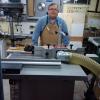The 3-phase motor on my dust collector (3hp) is controlled via a Teco FM-50-203, setup shown on the page Remote Powered VFD. I use a linear taper potentiometer (shown on attached photo below) to control the speed, which I reduce dramatically to use the system for clearing the air following tool operations which create dust not picked up by the dust collection system itself. I don't have a tachometer, but I'm guessing the rpm are 1/10th or even less of max when just used as an ambient air filter. I could probably "manually" adjust the frequency to approximate the speed, but I'm not sure it's relevant to the question. I used the Teco programming guide to set F_11 to 1, which gives 0-max frequency adjustment via the potentiometer.
Operationally, this system is not the best. The potentiometer doesn't reset when the machine is turned off. So, if I want to use a tool, I switch the remote control (see photo below) hanging on my belt, and realize I need to walk over and turn the potentiometer up. Once done with the machine operation, if I wish to keep the collector running to filter air, I need to walk over and turn the potentiometer down to the appropriate level. And then of course walk around and open up the gates I want to use to filter the air entrained dust. And then reverse when done. Too much walking and remembering.
Questions
- Is there a function on the Teco FM50 (JOG or SP1 or Set Speed?) that would allow me to use a switch (thinking the second channel of my remote) to activate a pre-set frequency reduction? This would solve all the electrical control issues mentioned above, and improve the user experience considerably.
- Is there any equipment-related risk at running the 3-phase Baldor motor at such a slow speed? The vfd has never (to date) logged a fault.





 Reply With Quote
Reply With Quote



